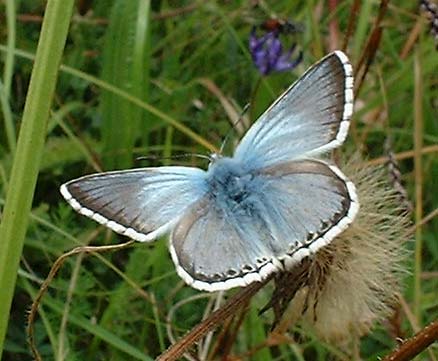|
|
 |
 |
| 1. | 2. | 3. |
|
|
 |
|
| 4. | 5. | 6. |
|
|
 |
|
| 7. | 8. | 9. |
|
|
 |
 |
| 1. | 2. | 3. |
|
|
 |
|
| 4. | 5. | 6. |
|
|
 |
|
| 7. | 8. | 9. |
In my opinion they
are:Male Adonis Blue - Female Chalkhill - Male Chalkhill
Female Common
Blue - Male Common Blue - Male Chalkhill (underside)
Reasoning behind ID's:
1) Adonis
Blue - Polyommatus bellargus. The
black veining is very prominent in the white
fringes.
The wings are also the very characteristic sky blue,
but
that isn't always a good guide in photos as the colouring
can
vary according to the angle of the wings to the light.
2) Female Chalkhill
Blue: Polyommatus coridon. Although
female Adonis Blues can look
similar
they are usually much darker in colour. Then again it
could
be a very worn Female Adonis. What was the date this
picture
was take?
3) Chalkhill Blue:
Classic textbook specimen with the pale blue
wings
going to black just before the white fringes. These can
almost
look white in bright sunlight when they are fresh.
A chalky
blue!
4) Female Common
Blue: Polyommatus icarus. Brown wings
with blue on them (i.e. NOT
a Brown
Argus). White flecking is not normally present on
the
female Adonis Blue and there are no prominent black veins
into
the white fringes either. Typical female Common Blue found
on
chalky soils in Southern England.
5) Male Common Blue:
Lilac Blue wings with no signs of black veining
towards
what remains of the white fringes.
6) Male Chalkhill
Blue underside: I had to think about this one.
At
this detail the Male Common Blue is very similar.
In
the following CHB = Chalkhill Blue, CB = Common Blue
The
black spotting on the upper forewing is quite strong -
typical
CHB and not typical for CB.
Very
little
showing of the orange linules on either fore or hind
wing
- Typical for CHB - Male CB has noticeable orange on rear wing.
Male
CB has a typical grey appearance on underside, this is off
white
with dark brown markings on rear wing - typical CHB.
As
an aside: a Male Adonis Blue underside will be a more red-ish
brown
than this Chocolate Brown compared to Burnt Umber.
The
fringes aren't clear enough to see any veining.
Hello
all,
a little tip to aid identification between Adonis and
Common
Blues as it's not always clear cut by the blue colour
if
the light catches them wrong.
Male
Common Blues are predominantly a greyish colour on their underwings,
whereas
the male Adonis Blues are predominantly a brown (tending towards
orangey
brown - Burnt Sienna to artists amongst you) on the underwing. So
if
the butterfly shows blue-brown-blue-brown
as it flies past you should be
fairly
sure it's an Adonis. Common Blues don't really show much of a
colour
change as you see upper and under wings during flight.
"The blue-brown-blue-brown I have found more likely to be female Common Blues. (Andy Horton)"
The
"sure fire" ID is the black veining, strong in the white margins, and
extending
into the blue wings, but you have to see them perched for that.
16
August 2002
Andrew
Daw
UK-LEPS
Discussion Group (for Butterflies and Moths)
Small
Blue 1st Brood -
Late May to late June (peak in early June)
2nd Brood - (limited emergence) Late July to August
Holly
Blue 1st Brood -
Early April to End of May (sometimes lingering into June)
2nd Brood - Mid-July to August.
3rd Brood - (occasional in good years) September
Brown
Argus 1st Brood - Beginning of May to Early June
2nd Brood - Late July to Mid September
Northern
Brown Argus - Mid-June to Mid-August
Silver
Studded Blue - Mid-June to Late July
(sometimes into August)
Common
Blue 1st Brood - Mid-May to Early July
2nd Brood - Late July to Mid September
3rd Brood - (occasional in good years) October
Adonis
Blue 1st Brood - End of
May to End of June
2nd Brood - Mid to Late August to Mid to Late September
Chalkhill
Blue
- Mid July to Early September
Large
Blue
- Mid June to Mid July
The
British blues have diverse habitat requirements and so it will require
some
travelling to pick up some species, even when they are out at the same
time.
Andrew
Daw
UK-LEPS
Discussion Group (for Butterflies and Moths)